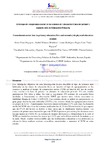El tiempo de compromiso motor en las sesiones de Educación Física del primer y segundo ciclo de Educación Primaria

Ver/
Use este enlace para citar
http://hdl.handle.net/2183/17721Coleccións
Metadatos
Mostrar o rexistro completo do ítemTítulo
El tiempo de compromiso motor en las sesiones de Educación Física del primer y segundo ciclo de Educación PrimariaTítulo(s) alternativo(s)
Commitment motor time in primary education first and second cycle physical education sessionsData
2016Cita bibliográfica
Sportis, 2016, 2 (2): 239-253 ISSN: 2386-8333
Resumo
[Resumen] Los principales objetivos de esta investigación fueron describir el tipo de sesiones más habituales en las clases de educación física en función del tipo de agrupamientos de los alumnos y analizar el tiempo de compromiso motor (TCM) en función del tipo de sesión, curso escolar o la hora de práctica en alumnos de educación primaria. En este estudio participaron 264 niños y niñas. En total se registraron 176 sesiones de educación física mediante la herramienta de observación TiPEF que mostro unos valores excelentes de fiabilidad (Kappa de Cohen = 0,95-0,99). Las sesiones donde se utilizó un agrupamiento de gran grupo fueron las más utilizadas (33,5%) y las sesiones donde los agrupamientos fueron en grupos de 4, 8 y 12 participantes fueron las menos utilizadas (5,7% cada una). La duración media del TCM para todas las sesiones analizadas fue de 21,4 ± 3,8 min/sesión, lo que supone que un 67,2% del tiempo se destino a otras tareas que no implicaron práctica motriz. Los alumnos de primer curso fueron los que más TCM dispusieron por sesión y los de tercer curso los que menos (p < 0,01). En las sesiones de después del recreo y a primera hora de la tarde el TCM que tenían los alumnos fue mayor (p < 0,01) que en la última sesión de la mañana y de la tarde. Puede resultar imprescindible que las instituciones educativas y los profesores de educación física realicen acciones específicas encaminadas a aumentar el TCM en estas edades. [Abstract] The main objectives of this study were to describe the most common type of sessions in physical education classes depending on the type of students groupings and to analyze the time available for practice (TCM) depending on the type of meeting, school year or when students practice the first, second and third year of primary education. This study involved 264 children who were studying in the first, second and third year of primary education. A total of 176 physical education sessions were recorded by observation tool TiPEF which showed excellent reliability (Cohen's Kappa = 0.95 to 0.99). The sessions where a cluster of large group used were the most used (33.5%) and sessions where the clusters were in groups of 4, 8 and 12 participants were the least used (5.7% each). The mean duration of TCM for all sessions analyzed was 21.4 ± 3.8 min / session, meaning that 67.2% of the time bound for other tasks that did not involve driving practice. The freshmen were the most TCM arranged by session and the third year the least (p <0.01). In sessions after recess and early in the afternoon TCM having students was higher (p <0.01) than in the last session of the morning and afternoon. It can be essential that educational institutions and physical education teachers perform specific actions to increase the TCM at these ages
Palabras chave
Acción motriz
Tiempo de práctica
Metodología
Enseñanza efectiva
Motor control
Practice time
Methodology
Effective teaching
Tiempo de práctica
Metodología
Enseñanza efectiva
Motor control
Practice time
Methodology
Effective teaching
Versión do editor
ISSN
2386-8333





